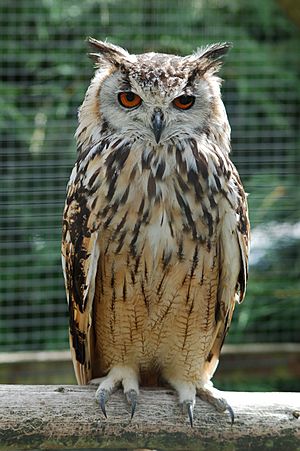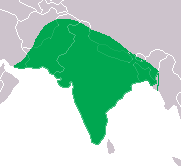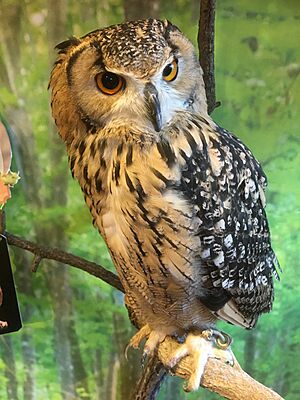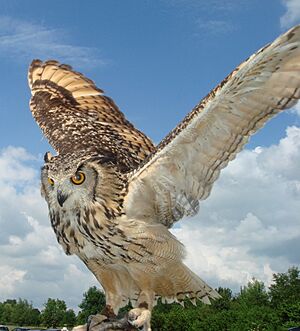Indian eagle-owl facts for kids
Quick facts for kids Indian eagle-owl |
|
|---|---|
 |
|
| Conservation status | |
| Scientific classification | |
| Genus: |
Bubo
|
| Species: |
bengalensis
|
 |
|
| Bounding distribution of Indian eagle-owl | |
| Synonyms | |
|
Urrua bengalensis |
|
The Bengal eagle-owl (Bubo bengalensis) is a big horned owl found in the Indian Subcontinent. People also call it the Indian eagle-owl or rock eagle-owl. These owls live in hilly, rocky areas with bushes and small trees. They have brown and grey feathers, with a white patch on their throat that has thin black stripes. You can often see them in pairs. They make a deep, booming sound, especially at sunrise and sunset.
Contents
About Its Name
Scientific Name History
The Bengal eagle-owl's scientific name is Bubo bengalensis. This name was first used by James Franklin in 1831. He named it after an owl found in the Bengal region of the Indian Subcontinent. For a long time, some scientists thought it was a type of Eurasian eagle-owl. But now, most agree it is its own unique species.
What It Looks Like
The Bengal eagle-owl looks a lot like the Eurasian eagle-owl. However, there are some small differences. Its face has a clear black border, which is not as strong in the Eurasian type. The feathers at the base of its wings are rufous and do not have stripes. The stripes on its tail are wider and tawny (yellowish-brown). When its wings are folded, you can see a large, pale patch on its shoulder feathers. Its inner claws are the longest. The last part of its toes does not have feathers.
Color Variations
These owls can have different colors. Some are dark brown on top, while others are pale and yellowish. Darker birds have streaks that join together on their head and neck. Lighter birds have thinner streaks. Even with these differences, they are smaller and more brightly colored than other similar owls nearby.
How Chicks Grow
Baby owls are born with soft white fluff. After about two weeks, this fluff is replaced by speckled feathers. After about a month, they get brownish feathers that look a bit like adult feathers. They get their full adult feathers much later.
Where It Lives
Bengal eagle-owls live in scrublands and light forests. They especially like rocky areas in the Indian Subcontinent, south of the Himalayas. They usually live below 1,500 meters (about 4,900 feet) in height. They avoid very wet forests and extremely dry places. They love rocky hills with bushes, deep valleys, and steep riverbanks. During the day, they hide under bushes, rocky ledges, or in big trees with lots of leaves, often near villages.
Behaviour and Life Cycle
Calls and Communication
These owls make a deep, booming call with two notes. Males make these "long calls" mostly at dusk during the breeding season. They call the most in February. Young owls make clicking and hissing sounds. They also spread their wings to look bigger if they feel scared. Adult owls will fly in zig-zag patterns and try to scare away anything that comes too close to their nest, including people.
What They Eat
Bengal eagle-owls mostly eat small animals like rodents throughout the year. But in winter, they eat more birds. Some of the birds they hunt include francolins, doves, Indian roller, shikra, black kite, house crow, and spotted owlet. They can even attack birds as big as a peafowl. They also eat flying foxes. In Pakistan, a type of rat called Nesokia indica is an important food source. They can also hunt mammals as big as an Indian hare. When they eat rodents, they tear them into pieces instead of swallowing them whole.
Reproduction and Nesting
The nesting season for Bengal eagle-owls is from November to April. The female usually lays three or four eggs. The eggs are creamy white, roundish, and smooth. They lay their eggs on the bare ground in a natural dip in a bank, on a cliff ledge, or under a bush. They often use the same nesting spot every year. The eggs hatch after about 33 days. The young owls stay with their parents and depend on them for almost six months.
In Culture
This large owl, with its unique face, big eyes, "horns" (ear tufts), and deep call, is part of many old stories and beliefs. Like many other large owls, some people used to think they brought bad luck. If their deep calls were heard from on top of a house, some believed it meant someone in the house would die. There are old stories about rituals involving catching and even harming these birds. Some beliefs said that if the bird was starved and beaten, it would speak like a human and tell the future or bring wealth. Another story involved killing the bird to find a special "lucky bone" that would move against the water current like a snake.




